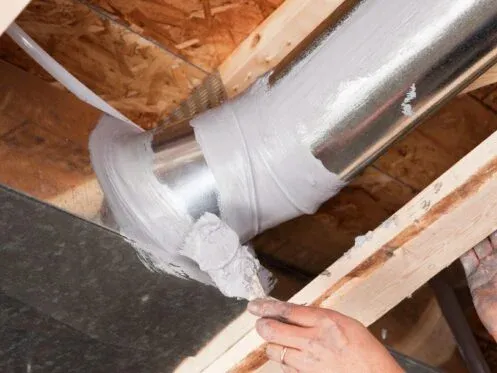Ductwork is an integral aspect of any central HVAC system. The ducts allow the conditioned air to flow from the system into your living spaces. If you have duct problems, you can experience many issues, including reduced comfort, worse air quality, and higher costs. A common challenge is that homeowners don’t associate the difficulties they’re experiencing with their ducts. Let’s explore the signs that might suggest that your ducts are bad.
Visible Damage
Depending on the location of your ducts, you might see evidence of exterior problems. If your ducts have insulation, the insulation may deteriorate or be wet or show signs that it was wet previously. Look for any drooping, which indicates failed mounting hardware. That sagging can break the seals between duct sections and put added strain on the other hangers. You should also look for any damage to the duct sections. Cracks, holes, and other imperfections allow for air leakage. You should never see any rust or other corrosion on your ducts. Any sign of damage calls for a call to a local ductwork services expert.
Duct Camera Inspections
The National Air Duct Cleaners Association estimates that the average household needs HVAC duct cleaning every three to five years. How fast dust accumulates can vary based on seasonal factors and the number of people and pets in the home. Many experts advise scheduling a duct camera inspection every other year to maintain clean, functional ducts. During an inspection, a technician will check the exterior of the ducts, but they’ll also use a high-definition camera. That will let them identify any potential duct issues from the inside. That includes dust accumulation but also:
- Moisture
- Worn seals
- Other debris
- Mildew or mold
- Pest infestations
- Damage to the duct walls
Air Balancing
Air balancing is an HVAC service that involves testing and calibrating airflow. It will generally encompass a duct camera inspection along with a range of other services. That may include adjusting the blower to provide the necessary cubic feet per minute. Traditional single-zone HVAC systems typically need air balancing every five years. Homeowners with zone control systems may need to schedule air balancing more often to reduce the risk of bad ducts going unnoticed for an extended period. If you’re experiencing potential duct problems and it’s been a while, schedule air balancing rather than just an inspection.
Rising Energy Costs
Ductwork, which is part of your home’s building envelope, can lead to significant energy losses. The Department of Energy estimates it can be between 25% and 40% of your total usage. Those studies prompted the Environmental Protection Agency to invest in duct sealing research. The result of those efforts is the aerosol-based duct sealing techniques many HVAC companies now use. If you notice an unexpected rise in your electricity or fuel costs, your ducts could be the cause. When conditioned air escapes, your system has to compensate by using more energy.
Irregular Cycling
Your HVAC system will often compensate by running more often and for longer periods. Consider that the typical cooling or heating cycle is 10 to 15 minutes, and it should occur twice or thrice an hour. Long cycling is when the system runs for longer than 15 minutes. It is not only wasteful but can cause excessive wear and tear on your equipment. Short cycling is when an HVAC system turns on and off more than three times an hour. This may happen when the system overheats, which can be the eventual result of substantial duct deterioration.
Poor Airflow
When your system functions well, conditioned air should settle into your living areas evenly throughout your home. Leakage in your ducts will disrupt this flow. You may notice when you put your hand to a vent that the airflow isn’t as strong as it once was. It’s important to note that you won’t necessarily experience the same flow from every vent. Some may feel normal while others experience reduced airflow.
Uneven Heating and Cooling
Poor airflow will result in uneven cooling and heating throughout a home. How that manifests in your home depends on its size and floor plan. You may experience warm or cool spots in certain rooms. Entire rooms may be warmer or cooler than others. It’s also common to experience sharp temperature differences between floors. If the difference between your upper floor and ground floor is 2 degrees or greater, there’s a problem.
High or Low Humidity
While an air conditioner isn’t a dehumidifier, it should maintain a reasonable relative humidity in a well-sealed home. If your home is cool but muggy, it could be your ducts. That’s because moist air from your attic or crawl space can get into the home. Air leakage can be problematic in winter, too, as it lets cold, dry air into the home. If you use a dehumidifier and/or humidifier, you may also notice that they’re not as effective as usual.
Loud Noises
Your ducts shouldn’t rumble or otherwise create noises when your HVAC system cycles on. Installers often recommend targeting 60 decibels (dB) or less for home HVAC systems. In that range, the noise made is comparable to a whisper. Vibrating and otherwise noisy ducts can increase that sound output to 70 dB or more, which is comparable to a vacuum.
Musty Odors
You shouldn’t smell any mustiness from your vents. Even fleeting mustiness can indicate a problem. If it’s been a while since you’ve scheduled an AC or heat pump tune-up, that smell could be related to the evaporator coil. Microbial growth can build up on the coil and create that smell. Otherwise, it could mean there’s mildew or mold in your ducts. That generally suggests that there is or was a moisture problem as well.
Diminished Indoor Air Quality
Bad ducts can lead to a much dustier home and a heightened presence of other allergens, too. Often, the earliest sign is someone with allergies experiencing worsened symptoms and more frequent attacks. You may notice more dust and other particles in the air. There may be persistent, unpleasant odors. You may also find dust accumulating around your baseboards faster than usual due to lower indoor air quality.
HVAC Filters Clog Fast
Another indication of a problem is how fast your supply filters need replacement. The average replacement timeline is three months. You may find yourself replacing it after a month from time to time. If you’re regularly replacing filters frequently, you likely have a problem related to the elevated presence of particulates in the air or the changes in static pressure affecting how air flows through the filters.
Dust in Your Vents
Dust your HVAC vents regularly when dusting your home. Tufts of dust shouldn’t be coming through the slots. When dusting, open the vents and clean the inner face of the vent and up into the duct mouth. There shouldn’t be a lot of buildup there. If there is, it’s time to schedule an inspection.
Professional Ductwork Services in Greater Sacramento
Atticman Heating and Air Conditioning, Insulation is an HVAC company located in Sacramento, CA. We proudly employ NATE-certified technicians who perform all our duct-related services. Our team designs and installs new duct networks and repairs existing ductwork. We also inspect, clean, sanitize, seal, and repair ducts. To learn more about our HVAC services in Davis, CA or to schedule an appointment, call us today or contact us online.


